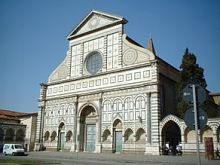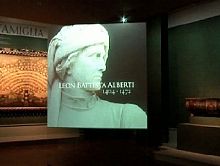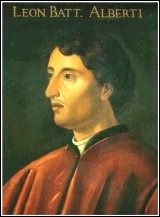The Renaissance Man
Leon Battista Alberti between Reason and Beauty
Florence, Palazzo Strozzi
Piazza Strozzi, entrance via Tornabuoni
From March 11th through 23 July 23th 2006
About 170 masterpieces for a major spectacular exhibition that will lead you to explore the art of one of the most important Italian Renaissance man: Leon Battista Alberti.

As the finale to the celebration of the sixth centenary of his birth, Florence dedicates a highly prestigious exhibition to Leon Battista Alberti (1404 - 1472) to bring to the attention of a broad public the most recent and sometimes surprising acquisitions relating to the encyclopaedic and spectacular works of one of its most extraordinary sons. A supreme architect, prodigious scholar, and highly acute art theorist, but also a town planner, mathematician, painter, archaeologist, physicist, chemist and musician, Alberti was, in short, the man that embodied the universal ideas of Renaissance humanism before Leonardo, an intellect that could apply itself to the most diverse fields, the emblematic product of a cultural ascent capable of formulating original syntheses of reason and beauty, of defining the rules of a new aesthetics, of shaping the sensibility of an epoch.
The exhibition, under the Patronage of the President of the Republic, will be held in Palazzo Strozzi (March 11 - July 23) under the title of The Renaissance Man. Leon Battista Alberti and the Arts of Florence between Reason and Beauty. About 170 works will be exhibited, some of them by Alberti, but most of them by the great artists who were influenced by his theories: Donatello, Ghiberti, Beato Angelico, Bernardo Rossellino Andrea del Castagno, Scheggia, Filippo Lippi, Filarete, Verrocchio, Botticelli, Fra Carnevale, Andrea Sansovino and many others, including a surprising Neri di Bicci, somewhat neglected to date, who is reintroduced in this exhibition as a faithful interpreter of the new spirit of the time.

There are 34 paintings, 22 drawings, 30 sculptures or reliefs, 4 architectural elements, 11 plaster casts, 21 exemplars of applied arts (fabrics, models, gold and silverware, etc.), 6 medals, 20 manuscripts, some of them illuminated, 5 letters, 13 printed volumes, etc.. Among the most precious and famous pieces are some extraordinary works by Donatello: the Madonna and Child (Piot), exceptionally on loan from the Louvre, Herod's Banquet from the Musée des Beaux Arts of Lille, the Virgin and Child with Angels from the Victoria and Albert Museum. Other works on display include: the wall panel showing the Siege of Troy by the Master of Apollo and Daphne, on equally exceptional loan from New York University, the plaque considered a Self-portrait of Alberti in Profile from the National Gallery of Washington, Botticelli's Calumny from the Uffizi, the Silver Cupboard by Beato Angelico from the Museo di San Marco, The Ideal City from Urbino.
The exhibition also continues outside Palazzo Strozzi, in the form of an Alberti itinerary marking the works designed by Alberti the architect and places where his intellectual suggestions can be perceived.
Leon Battista Alberti

Leon Battista Alberti was born in Genoa in 1404. The first theorist of Humanist art, Alberti belonged to an important Florentine family that had been exiled from Florence since 1387. When the family returned to the city in 1429 Alberti gained access to the city's great architecture and art which he studied extensively. Well-versed in Latin and Greek, Alberti never received a formal architectural education. His architectural ideas were the product of his own studies and research.
Alberti's two main architectural writings are De Pictura (1435), in which he emphatically declares the importance of painting as a base for architecture and De Re Aedificatoria (1450) his theoretical masterpiece. Like Vitruvius's Ten Books on Architecture, De Re Aedificatoria was subdivided into ten books. Unlike Vitruvius's book, Alberti's told architects how buildings should be built, not how they were built. De Re Aedificatoria remained the classic treatise on architecture from the sixteenth century until the eighteenth century.
The unfinished Tempio Malatestiano in Rimini (1450) was the first building that Alberti designed and attempted to build based on his architectural principals. Up to that point Alberti's architectural experience was purely theoretic. The facade of Santa Maria Novella (1458-71) is considered his greatest achievement since it allows the pre-existing and newly added parts of the building to merge into a clear statement of his new principles.
Alberti died in Rome in 1472.


